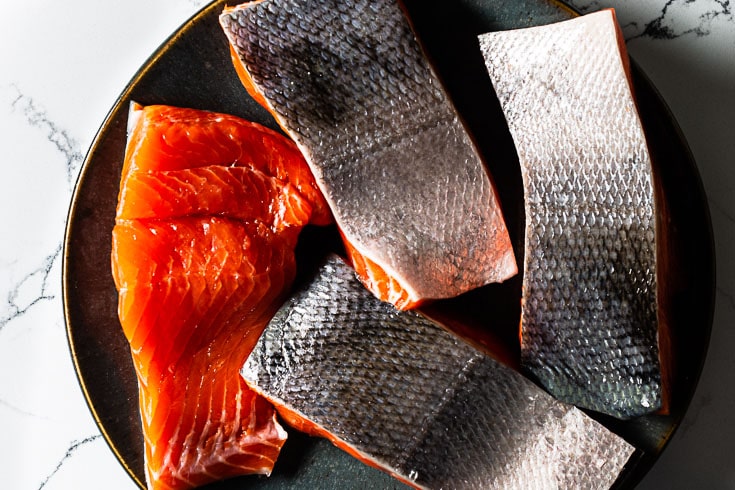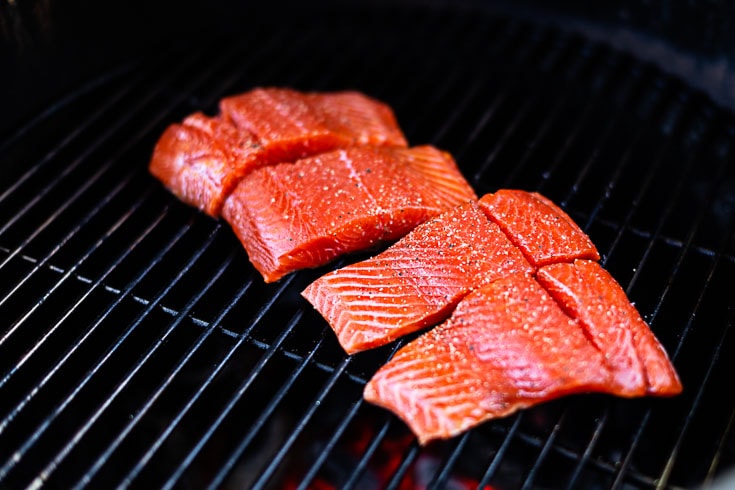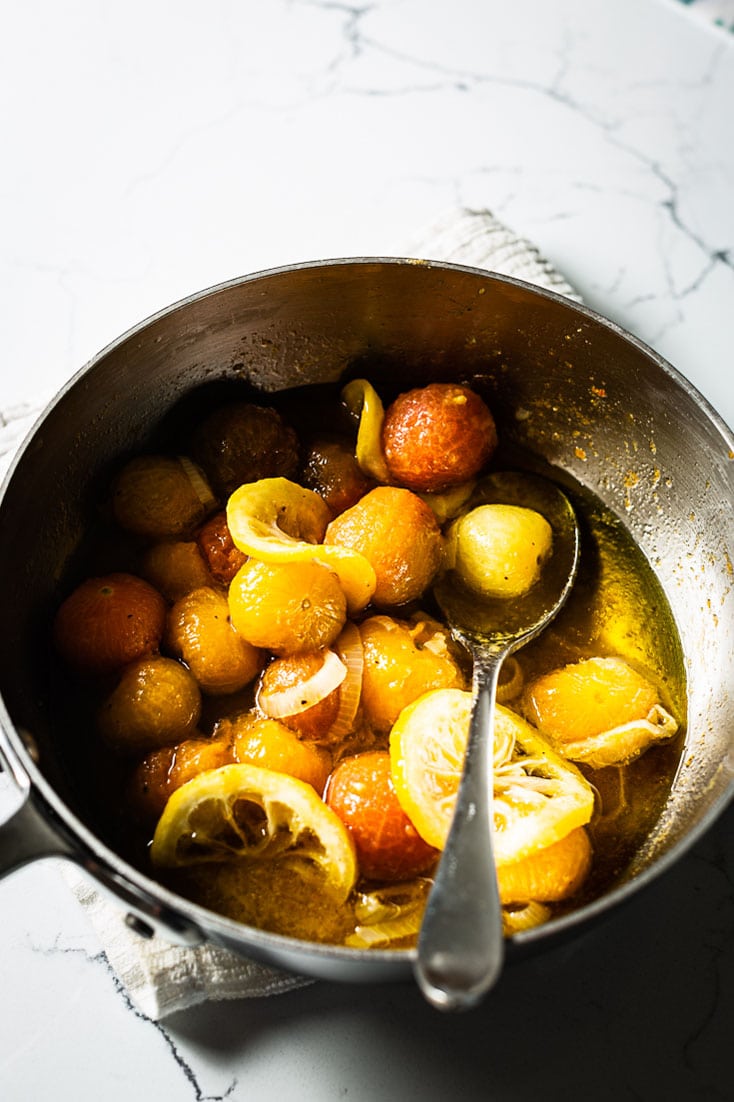When it comes to salmon, it’s all about that crispy skin, and grilling just on the skin side gets the skin super crispy. Just place it skin side down, close the lid and wait for 7 to 10 minutes until the salmon is grilled to perfection.
Imagine for a second that you sitting next to the Copper River in Alaska. You glance across at the fast-moving currents to see teal blue glaciers in the distance, the wind is whistling through the alder trees that line the river banks, and the smell of the wood fire is in the air. Now that you are in that magical spot, imagine grilling the freshest piece of salmon that was just caught right in the water right in front of you. That’s what you can think of and talk about when cooking salmon on the grill.

This recipe is for the wild salmon purist’s grilled salmon. When you have the best wild-caught salmon, there’s no need to cover it up with a marinade (as good as those taste). You want to taste the wild salmon in all its glory, how it is meant to be eaten. Applying beautiful wood-fired heat from the grill is so natural for salmon, and is how it’s cooked in Alaska along the Copper River where it comes from.
Summer is salmon season and the time for extra-simple cooking outside. So light up the grill to keep the cooking outdoors to enjoy the warm nights and the smell of the fire. That is the smell of summer. Salmon is born in the wild, so being outside to cook and enjoy it is only appropriate.
The 3 Keys to the Best Grilled Salmon
- Buy high-quality, super-fresh wild salmon.
- Season right before cooking, and grill skin side down all the way.
- Don’t overcook it.
Grilling theories: There are a few theories for the best way to grill salmon. Skin side up first, skin side down first, cooked on aluminum foil, cedar planks, etc. The theory to start grilling skin side up, then flip it to finish cooking does work pretty well. However, the skin doesn’t have the chance to get crispy this way, so it’s not the winner in my book.
The best way to grill salmon is skin-side down all the way through. There are a few reasons for this.
Reasons skin side down all the way is the best:
- Crispy salmon skin. Isn’t that reason enough? The skin gets super crispy and the skin is the best part.
- The skin protects the salmon while the closed grill acts like an oven to delicately and evenly cook the filets.
- You don’t have to flip it. Just place it on the grill, close the lid and wait for perfection. Not only is this more hands-off, but it keeps the fish intact.
- Grilling the flesh side on a hot grill can make it slightly tough and dried out if left too long.
- It’s easier not to overcook the salmon when just the skin is in direct contact with the heat.
How Much Salmon Do You Need per Person?
Figure 6 to 8oz per person portion sizes depending on what else is on the menu. Go with smaller 4oz per person portions of salmon for a potluck where there are other proteins and lots of sides. If the salmon is the main attraction, go towards 8oz per person.

Tips for Buying Salmon to Grill
- Buy thicker filets towards the head end of the fish and avoid the tail if not buying the whole filet. The tail is thinner and will cook more quickly than the rest.
- Buy wild salmon whenever you can.
- Fresh is great, but frozen is better if fresh isn’t available or wild salmon isn’t in season.
- Ask your fishmonger where the fish came from and how long it has been out of the water.
- Keep it fresh when you get home. Store it with ice around the bag to keep it extra cold.
Wild vs Farm-Raised Salmon
There’s a big difference in wild and farm-raised salmon. Not just with the taste and appearance, but how the salmon actually cooks on the grill. Wild salmon from the North Pacific has a deep red flesh, whereas farmed salmon is either very pale or dyed to have a reddish color. Wild salmon is available fresh when it is in season, and available frozen all year long.
Wild salmon is sustainable. When I visited the Copper River Salmon fishery, it was enlightening to learn about the life cycle of the fish and just how regulated and positive the population levels are.
Reason #38 Why You Should Always Buy Wild Salmon
Wild salmon has to eat to survive, and it eats as much as it can for its journey almost 300 miles up the river. That means more good fat, flavor and nutrients that get past right to the people who eat it (us).
How to Remove the Bones from Salmon Filets
Removing the pin bones prior to cooking salmon is an important step for optimal enjoyment of the fish. The right tool for the job is a pair of fish bone tweezers. If you don’t have any, I would highly recommend picking some up. If you are in a pinch (no pun intended), you can totally use a pair of clean needle-nose pliers.
- Start by very gently running the back of a chef knife along the flesh side of the filet from the tail end to the head to bend the bones for easier removal. This will make it much easier to find and remove the pin bones.
- Start at the tail end and pick them out one by one, pinching with the tweezers and giving a slight wiggle while you pull them out. Feel along all sides for any stray bones.
Seasoning for Grilled Salmon
When using very high-quality wild salmon, it is already packed with flavor so you don’t want to overpower it with too much seasoning. You want to taste the salmon for what it is. Simply season it on all sides with kosher salt and freshly ground black pepper. The salt will help bring out those natural salmon flavors.
How to Know When the Salmon is Finished Cooking?
The internal temperature is the deciding factor more than it is the time that determines doneness. It’s always best to use a digital probe thermometer (affiliate). For medium doneness, cook to an internal temperature of 125 to 130 degrees F. When the salmon is finished cooking, you can peek behind or see some of the white albumin starting to come out. Albumin is a harmless coagulated protein that often seeps out of cooked salmon.
How Long Does it Take to Cook Salmon on the Grill?
A filet of salmon will take about 6 to 10 minutes total to cook on a medium-high grill with the cover on. As previously mentioned, it’s best to determine doneness by the internal temperature rather than time because there are a lot of variables including the thickness of the fish, the starting temperature of the fish and the grill temperature. Salmon is fairly forgiving, but error on the side of less rather than more time.
Skin On or Skin Off for Grilling Salmon?
Grilling salmon with skin is definitely the way to go. Whenever possible, buy salmon with the skin. Not only will the skin keep the filets together when on the grill, but crispy salmon skin is absolutely delicious. If you prefer not to eat the skin, just remove it after cooking.
Do You Cook Salmon Skin Up or Down?
Cook the salmon skin-side down. Crispy salmon skin is one of the joys of life. If you aren’t eating the crispy super flavorful salmon skin, you are totally missing out. It also helps protect the fish from drying out.

Tips for Grilling Salmon
- Bring the salmon to room temperature before grilling for even cooking.
- Season the salmon liberally just before cooking and not in advance. Salting tip: salt with your fingers from high above the fish to get an even distribution.
- Always start with clean grill grates to prevent sticking.
- Brush the salmon with canola or avocado oil prior to placing it on the grill to help prevent sticking.
- Grill individual portions (4 to 8 oz) rather than the whole filet. Small portions are easier to manage on the grill and are easier to serve.
- Grill over medium heat. Too hot and it can burn, too low and it can stick.
- Use a fish spatula instead of tongs for handling the salmon on the grill. Tongs can damage the delicate fish.
- Handle it as little as possible when grilling. The more you touch it the more chance that it can fall apart.
- Don’t overcook it. Use a Thermapen probe thermometer (affiliate) to check for doneness. If you aren’t sure, remove it early. You can always add it back to the grill on a metal sheet pan or foil to continue cooking if needed. You can’t go back the other way.
Key Temperatures for Grilled Salmon
The ideal cooked internal temperature for salmon is between 120 and 130 degrees Fahrenheit. Why the big range? That’s because just like a steak, it depends on your preference of texture and it also depends on the type of salmon you are cooking. Certain types of wild salmon are much better cooked to just 120° F.
While the USDA recommends a minimum internal temperature of 145° F to be safe, this is overcooked in my (and most people’s) opinion. The perfect temperature is 125° F.
Finished internal temperature:
Medium-Rare: 120 to 125° F
Medium: 125 to 130° F
USDA recommends: 145° F (this will be overcooked)
Grill temperature: medium. Not too high or the salmon will overcook on the outside before the inside cooks. Too low and the skin won’t get crispy and you will miss out on extra flavors.
How to Grill Salmon
- Pre-heat the grill to medium heat.
- Dry the room temperature salmon filets with paper towels, brush all sides with oil and season with Kosher salt and freshly ground pepper.
- Place the salmon filets skin side down on the grill and close the lid.
- Grill for on the skin side for a total of about 6 to 8 minutes, or until the internal temperature reaches 125° to 130° Fahrenheit (140° for well done). If needed, you can flip the salmon and cook quickly on the flesh side.
- Remove from the grill and rest for a few minutes before serving.
Grilling Salmon on Foil
You can totally grill salmon on foil and there are benefits. However, one of the reasons for cooking on the grill is the flavor that comes from the flame. The main benefit of cooking on foil is how easy it is to place it on the grill and remove it all without having to turn it or get any dishes dirty.
Place the salmon filet on aluminum foil that you have created a rim around. Drizzle the fish with olive oil, season with salt & pepper and leave it skin-side down. Place directly on the hot grill and cook on the skin side (turn if desired) until it reaches the desired internal temperature. Remove the salmon and foil from the grill and place directly on a serving platter.
Sauces for Grilled Salmon
- Burst Cherry Tomato sauce (featured below)
- Chimichurri
- Lemon-caper butter sauce
- Pesto sauce
- Tartar Sauce
- Chive-Walnut Pistou
- Hollandaise
- Herb Butter
Burst Cherry Tomato Sauce
While there are so many great sauce pairings for grilled salmon, a simple burst cherry tomato sauce is extra summery with heirloom tomatoes. It couldn’t be easier and can also be made right on the grill. Add all the ingredients to a small pot and let it simmer slowly for 7 to 10 minutes. You can burst the tomatoes with the back of a wooden spoon. Tip: Buy extra tomatoes and make an heirloom tomato salad with the same ingredients.
If you don’t plan on making a sauce, simply drizzle a little flavor-infused olive oil like roasted garlic or Meyer lemon to add a fantastic finish.

When you discover a burst cherry tomato sauce, it will seriously blow your mind. It’s so simple, yet tastes so complex. The sauce makes itself when you put it on the heat.
Pro tip: How to peel cherry tomatoes: Slightly tedious, but totally worth it. Score the end with a very sharp knife. Submerge into boiling water for 15-30 seconds, just until the skin starts to separate where the score marks are. Immediately transfer to an ice bath. Use the paring knife to peel back the skin.
Sides for Grilled Salmon
- Grilled asparagus
- Tomato salad
- Grilled Corn
- Sautéed corn
- Tomato risotto
- Arugula salad with a lemon vinaigrette
What Wine to Pair with Grilled Salmon?
You can’t go wrong with pinot noir. Also, a fruity rosé or a pinot gris from the Oregon coast will pair beautifully.
More Delicious Salmon Recipes
- Salmon Pasta with Creamy Lemon Vodka Sauce
- Crispy Skin Pan Seared Salmon
- Simple Smoked Salmon
- Sous Vide Salmon with Meyer Lemon Risotto
- Cold Smoked Salmon
- Salmon Burgers

Crispy Skin Grilled Salmon
Ingredients
- 4 6-8 oz Wild Salmon Filets (such as Copper River Sockeye, King or Coho)
- canola or avocado oil
- Kosher Salt & Freshly Ground Pepper
Burst Tomato Sauce
- 2 cups Cherry Tomatoes
- 1/2 cup Extra Virgin Olive Oil
- Lemon slices from 1/2 lemon + zest
- 1/2 Medium Shallot , thinly sliced
- 2 Garlic Cloves , thinly sliced
- Fresh Herbs such as parsley, basil, chives or thyme
- Kosher Salt & Freshly Ground Pepper
Instructions
To grill the Salmon
- Prep the grill and bring to medium-high heat.
- While the grill heats up, remove the salmon fillets from the refrigerator so they can come to room temperature. This will help them cook more evenly. Pat dry with paper towels and drizzle a little oil over the filets and brush to coat all sides.
- Season all sides with kosher salt & freshly ground black pepper.
- When the grill is heated, place the salmon skin-side down and close the lid.
- Cook skin side down for the whole time for about 6 to 8 minutes total, or until the internal temperature reaches 125 to 130 degrees F (140 for well done). Use a probe thermometer to check for doneness.
- Carefully transfer the cooked salmon to plates to rest for 2 minutes before serving with the sauce.
To make the Burst Cherry Tomato Sauce
- Place all of the sauce ingredients in a small saucepan and place over medium heat (stove or grill). Simmer for about 7 to 10 minutes, or until the tomatoes have burst into the olive oil (which can also be done with the back of a spoon).
Notes
- Keep an eye on the heat when the salmon is cooking. You don’t want it to get too high, which can easily overcook the salmon.
- If you prefer more well done salmon, you can turn the salmon over and cook for an additional 1 to 2 minutes on the flesh side.



Medium high grill? Direct or indirect?
Medium-High and over direct heat.
This looks great! If I use aluminum foil, will the skin still get crispy? I’m going to try this recipe tonight!
Yeah, the skin should still get somewhat crispy. One of the benefits of foil is the easy transfer from the kitchen to the grill. However, with this method, the foil isn’t really pre-heated so you don’t get quite the same direct heat crisp. I would add some oil between the salmon and the foil which should help. Let me know how it turns out. 🙂
I did it both ways and didn’t try the aluminum version soon enough to see if it was crispy on the bottom. After sitting a bit, it wasn’t. The other was nicely crispy and the sauce was fantastic! Thanks for a great easy recipe!!!
So glad to hear it was fantastic and for your test about foil vs non foil. 🙂
That is a gourmet salmon dish but with a simple grill recipe. I normally grill my salmon with soy and garlic or just salt, but this is right up my alley with the tomato sauce. Great grilling and shopping tips also, thanks for another favorite!
This is the best way I have ever cooked salmon. Thick salmon fillets are always a challenge to cook perfectly. Part is usually overcook and part undercooked. Cooking on charcoal with skin on was perfect. And I have never had salmon skin before…its actually quite good. The smokiness from the charcoal was perfect also. I agree withe the recommendation to cook to 125 degrees; that is perfect.
The burst cherry tomato sauce was also very good and pairs great with the salmon. This is my new go to recipe for quick tasty salmon dinners!
Hey Josh,
So glad to hear it was the best way you have ever cooked salmon. Also glad you ventured to try eating salmon skin. They even have crispy salmon skin sushi rolls. 🙂